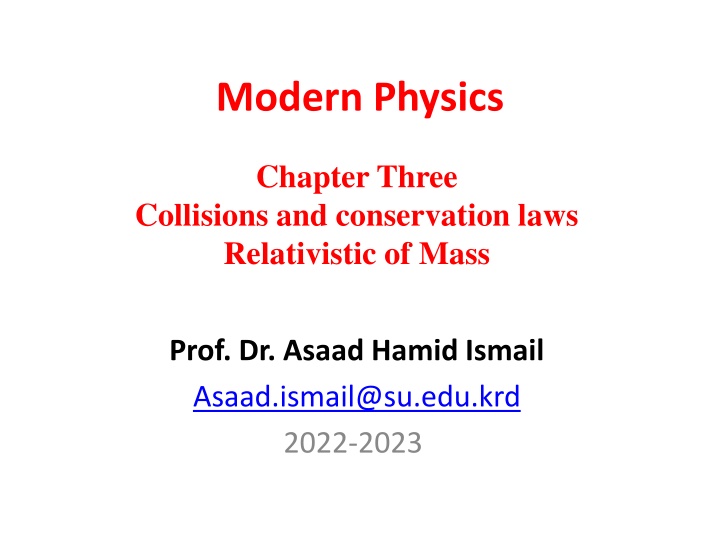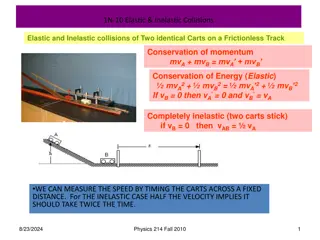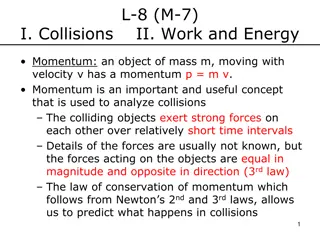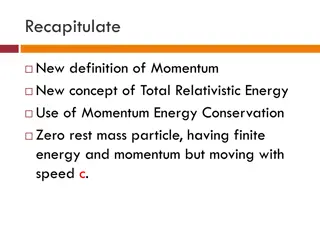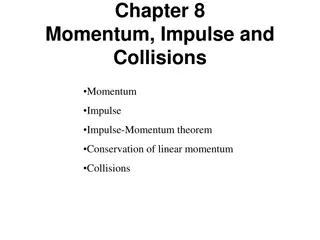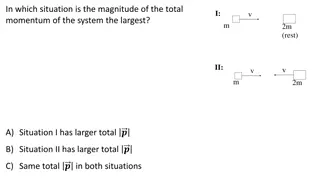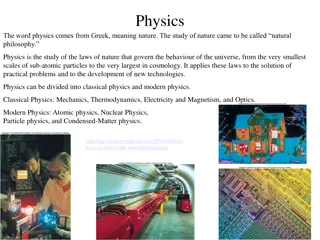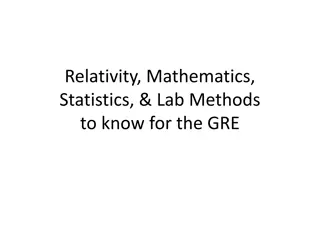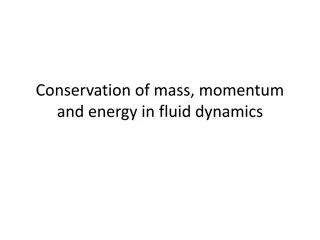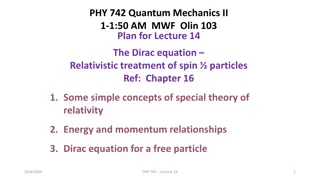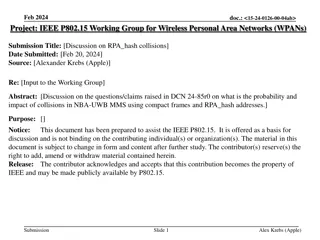Collisions and Conservation Laws in Relativistic Mass
c The concept of relativistic mass in the special theory of relativity, conservation of momentum, and the impact of mass and velocity on momentum in collisions are explored. The law of conservation of momentum survives high velocities when defined correctly. Discussions on perfectly elastic collisions and momentum conservation in different frames are presented.
Download Presentation

Please find below an Image/Link to download the presentation.
The content on the website is provided AS IS for your information and personal use only. It may not be sold, licensed, or shared on other websites without obtaining consent from the author.If you encounter any issues during the download, it is possible that the publisher has removed the file from their server.
You are allowed to download the files provided on this website for personal or commercial use, subject to the condition that they are used lawfully. All files are the property of their respective owners.
The content on the website is provided AS IS for your information and personal use only. It may not be sold, licensed, or shared on other websites without obtaining consent from the author.
E N D
Presentation Transcript
Modern Physics Chapter Three Collisions and conservation laws Relativistic of Mass Prof. Dr. Asaad Hamid Ismail Asaad.ismail@su.edu.krd 2022-2023
Chapter Three Collisions and conservation laws Relativistic Mass Relativistic mass, in the special theory of relativity, the mass that is assigned to a body in motion. In physical theories prior to special relativity, the momentum p and energy E assigned to a body of rest mass m0and velocity v were given by the formulas p = m0v and E = E0+ m0v2/2, where the value of the rest energy E0was undetermined. In special relativity, the relativistic mass is given by m = m0, where = 1/Square root of (1 v2/c2) . Then the corresponding formulas for p and E are p = mv and E = mc2, respectively. The relativistic mass m becomes infinite as the velocity of the body approaches the speed of light, so, even if large momentum and energy are arbitrarily supplied to a body, its velocity always remains less than c.
The Law of Conservation of Momentum and Relativistic Mass In classical physics, momentum is a simple product of mass and velocity. However, we saw in the last section that when special relativity is taken into account, massive objects have a speed limit. What effect do you think mass and velocity have on the momentum of objects moving at relativistic speeds? Momentum is one of the most important concepts in physics. The broadest form of Newton s second law is stated in terms of momentum. Momentum is conserved whenever the net external force on a system is zero. This makes momentum conservation a fundamental tool for analyzing collisions. All of Work, Energy, and Energy Resources is devoted to momentum, and momentum has been important for many other topics as well, particularly where collisions were involved. We will see that momentum has the same importance in modern physics. Relativistic momentum is conserved, and much of what we know about subatomic structure comes from the analysis of collisions of accelerator-produced relativistic particles. The first postulate of relativity states that the laws of physics are the same in all inertial frames. Does the law of conservation of momentum survive this requirement at high velocities? The answer is yes, provided that the momentum is defined as follows. 3/19/2025
Let us first consider the following perfectly elastic collision between two balls that are identical when observed in a stationary rest frame S in the figure . Applying the law of conservation of momentum to the collision, we obtain momentum before collision = momentum after collision 3/19/2025
Consider a similar perfectly elastic collision, the ball B only is thrown by a moving observer. The stationary observer is in the frame S and the moving observer is in the moving frame S , when Then The law of conservation of momentum can be retained if we allow for the possibility that the moving mass changes its value because of that motion. That is, if both sides of this equation are divided by Vy we get So
Now mAis the mass of the ball in the stationary frame and mBis the mass of the ball in the moving frame. If we consider the very special case where Vy is zero in the S frame, then the mass mAis at rest in the rest frame. We now let mA= m0, the mass when it is at rest, henceforth called the proper mass or rest mass, and we let mB= m, the mass when it is in motion. So the above equation becomes This equation is defines the relativistic mass m in terms of its rest mass mo. Because the term is always less than one, The relativistic mass m, the mass of a body in motion at the speed v, is always greater than mo, the mass of the body when it is at rest. The variation of mass with speed is again very small unless the speed is very great. 3/19/2025
Example The relativistic mass for various values of v. Find the mass m of a moving object when (a) v =447km/hr, (b) v = 1610 km/s =1000 miles/s, (c) v = 0.8c, and (d) v = c. The solution The relativistic mass m is found in terms of its rest mass moby (a) For v = 1610 km/hr = 447 m/s, we obtain Thus, at this reasonably high speed there is no measurable difference in the mass of the body. (b) For v = 1610 km/s, Thus, for a speed of 1610 km/s = 3,600,000 mph, a speed so great that macroscopic objects cannot yet attain it, the relativistic increase in mass is still practically negligible (c) For v = 0.8c, For the rather large velocity of 0.8c, the increase in mass is very significant (d) for v=c Thus, as a particle approaches the speed of light c, the mass of the particle approaches infinity. Since an infinite force and infinite energy would be required to move an infinite mass it is obvious that a particle of a finite rest mass mocan never be accelerated to the speed of light. 3/19/2025
Relativistic momentum According to Einstein s theory the relativistic momentum of a particle with mass and velocity is given by where v is the speed of the particle and c is the speed of light in a vacuum. The speed of light in a vacuum c , plays an important role throughout special relativity. Among other things it represents an upper limit to the speed of any particle. The above formula implies that the momentum of a particle increases more rapidly with increasing speed than the Newtonian relation (p=mv) predicts. This is shown in the curve, where the behaviour of the Newtonian and relativistic definitions of momentum magnitude are compared. You can see the good agreement at low speed, but you can also see the increasing discrepancy as the speed increases. Note that the relativistic definition does not extend beyond c c. This reflects the fact that in special relativity it is impossible to accelerate a particle with mass to the speed of light, as you will soon see NOTE: From the curve : The magnitude of the momentum of a particle of mass m plotted against the particle s speed according to Newtonian mechanics and special relativity. The Newtonian relation closely approximates that of relativity v for values of that are small compared with the speed of light c, .
Relativistic linear momentum The Lorentz force is the combined force on a charged particle due both electric and magnetic fields, which are often considered together for practical applications. If a particle of charge q moves with velocity v in the presence of an electric field E and a magnetic field B, then it will experience a force: Electrons were first accelerated by a large potential difference until they were moving at high speeds. They then entered a velocity selector. By varying the electric and magnetic field of the velocity selector, electrons with any desired velocity can be obtained by the equation v = E/B These electrons were then sent through a uniform magnetic field B where they were deflected into a circular path. The centripetal force was set equal to the magnetic force, and we obtain When the above formula treat the mass as the relativistic mass it becomes The above equation shows that the momentum of a relativistic particle of known charge q may be determined by measuring its radius of curvature r in a known magnetic field, B. This technique is routinely used to determine the momentum of subatomic particles from photographs of their tracks in space. Because B, r, and v could be measured in the experiment, the ratio of the charge of the electron q (or e ) to its rest mass mo, found from the equation is mo The variation of mass with speed truly points out the meaning of the concept of inertial mass as a measure of the resistance of matter to motion. The rest mass moshould probably be called the quantity of matter of a body since it is truly a measure of how much matter is present in the body With this new definition of relativistic mass the relativistic linear momentum can now be defined as
Example (about Momentum of an Electron) An electron, which has a mass of 9.11 x 10-31kg, moves with a speed of 0.750c. Find its relativistic momentum and compare this with the momentum calculated from the classical expression The solution But , the incorrect classical expression would give Hence, for this case the correct relativistic result is greater than the classical result! 3/19/2025
The law of conservation of momentum now holds for relativistic mechanics just as it did for Newtonian mechanics. Thus, momentum is always conserved if the relativistic mass is used and the law of conservation of momentum is preserved for relativistic mechanics. Newton s second law is still valid for relativistic mechanics, but only in the form 3/19/2025
The Law of Conservation of Mass-Energy As we have just seen, because the mass of an object varies with its speed, Newton s second law also changes for relativistic motion. We now ask what effect does this changing mass have on the kinetic energy of a moving body? How do we determine the kinetic energy of a body when its mass is changing with time? First let us recall how we determined the kinetic energy of a body of constant mass. The kinetic energy of a moving body was equal to the work done to put the body into motion i.e. the relativistic mass m can also be write as That is, the relativistic mass is equal to the rest mass plus the change in mass due to motion. Substituting the above equations we get The total relativistic energy of a body is, therefore, defined as This equation states that the total energy of a body is equal to its kinetic energy plus its rest mass energy The result of these equations is that energy can manifest itself as mass, and mass can manifest itself as energy. In a sense, mass can be thought of as being frozen energy
Example How much energy is stored in a 1.00-kg mass? The solution The rest mass energy of a 1.00-kg mass, given by equation This is an enormous amount of energy to be sure. It is about a thousand times greater than the energy released from the atomic bomb dropped on Hiroshima . 3/19/2025
-We have found the total relativistic kinetic energy to be given by equation of What does this relation for the kinetic energy reduce to at low speeds? The term for For relatively small velocities Notice that the relativistic equation for the kinetic energy reduces to the classical form of the equation for the kinetic energy at low speeds as would be expected. We can check this by using the binomial expansion Substituting this into Equation of K.E gives which agrees with the classical result. A graph comparing the relativistic and nonrelativistic expressions for v as a function of K is given in the following figure
A graph comparing the relativistic and nonrelativistic expressions for speed as a function of kinetic energy. In the relativistic case, v is always less than c. Note that in the relativistic case, the particle speed never exceeds c, regard- less of the kinetic energy, as is routinely confirmed energy particle experiments. in very accelerator high 3/19/2025
Example about (Relativistic and classical kinetic energy.) A 1.00-kg object is accelerated to a speed of 0.4c. Find its kinetic energy (a) relativistically and (b) classically. The solution (a)The relativistic kinetic energy of the moving body is (b)The classical determination of the kinetic energy is That is, if an experiment were performed to test these two results, the classical result would not agree with the experimental results, but the relativistic one would agree 3/19/2025
Examples about (Kinetic energy of an electron) An electron is accelerated through a uniform potential difference of 2.00 106V. What is its kinetic energy as it leaves the electric field? The solution The kinetic energy is It is customary in relativity and modern physics to express energies in terms of electron volts, abbreviated eV. The unit of energy called an electron volt is equal to the energy that an electron would acquire as it falls through a potential difference of 1V. Thus, the electron volt is also a unit of energy. Now we can express the KE in the example in electron volts as 3/19/2025
By far, the greatest implication of equation (E=mc2) is that mass and energy must be considered as a manifestation of the same thing. Thus, mass and energy are not independent quantities, just as we found that space and time are no longer independent quantities. Just as space and time are fused into spacetime, we must now fuse the separate concepts of mass and energy into one concept called mass- energy. What was classically considered as two separate laws, namely the law of conservation of mass and the law of conservation of energy must now be considered as one single law -- the law of conservation of mass-energy. That is, mass can be created or destroyed as long as an equal amount of energy vanishes or appears, respectively Because mass and energy can be equated it is sometimes desirable to express the mass of a particle in terms of energy units. Let us start by defining an atomic unit of mass, called the unified mass unit, and defined as one-twelfth of the mass of the carbon 12 atom. Recall that the mass of a molecule is given by m = M / NA ; where M is the molecular mass of the molecule and NA is Avogadro s number. For a single atom the molecular mass is replaced by its atomic mass and the mass of a single atom is given by 3/19/2025
The masses of some of the elementary particles in terms of unified mass units and MeVs are given as rest mass of proton = mp = 1.00726 u = 938.256 MeV rest mass of neutron = mn = 1.00865 u = 939.550 MeV rest mass of electron = me = 0.00055 u = 0.511006 MeV rest mass of deuteron = md = 2.01410 u = 1875.580 MeV Example The energy of the deuteron. Deuterium is an isotope of hydrogen whose nucleus, called a deuteron, consists of a proton and a neutron. Find the sum of the rest mass energies of the proton and the neutron, and compare it with the rest mass energy of the deuteron. The sum of the rest mass energy of the proton and neutron is 3/19/2025
Energy of the fusion process That is, some mass m and hence energy is lost in combining the proton and the neutron. The lost energy that binds the proton and neutron together is called the binding energy of the system. This is the amount of energy that must be supplied to break up the deuteron. A further and extremely important application of mass-energy conversions occurs in the fusion of light atoms into heavier atoms. The most famous of such fusion processes is the conversion of hydrogen to helium in the sun and in the hydrogen bomb. An extremely simplified version of the process can be obtained by considering the mass of helium as consisting of two protons, two neutrons, and two electrons. The atomic mass of helium, as determined by the rest masses of its constituents, is If this value is compared to the atomic mass of helium from the table of elements we find Hence, helium is lighter than the sum of its constituent parts. The difference in mass between helium and its constituent parts is
